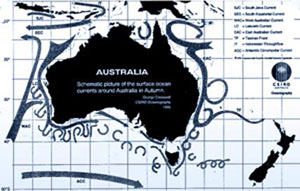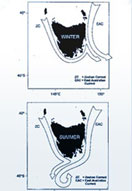Long Term Cycles

As well as seasonal cycles of abundance, zooplankton respond to much longer climatic and oceanographic cycles. The Southern Oscillation is an ocean/atmosphere interaction that was first recognised as El Niño, in the east Pacific off the coast of Peru. It is now known to be an ocean-wide phenomenon (El Niño-Southern Oscillation, ENSO) and its effects can be detected off Australia.
The first indications of El Niño are a weakening of south east trade winds (winds that blow from the south-east towards the equator) and a warming of the surface waters off South America. These winds normally drive an upwelling off the Peru coast, resulting in enrichment of the surface waters and very productive fisheries, including the target of what was once the world’s largest single species fishery: the Peruvian anchoveta.
When the south-east trade winds relax, warm nutrient-poor water floods back down the Peruvian coast with disastrous effects on local fisheries. The effects of El Niño off south east Australia are that the major current system, the warm East Australian current, does not penetrate as far south, resulting in cooler surface waters and westerly winds are stronger.
The net effect is for more productive surface waters, that are characterised by large phytoplankton species and aggregations of the coastal krill, Nyctiphanes australis. El Niño conditions occur approximately every 2–7 years. In between El Niño events are what are known as La Niña conditions that are characterised by warm, low productivity surface waters with low zooplankton biomass, and relatively calm weather. Superimposed on the Southern Oscillation cycle, there appears to have been a gradual warming of surface waters over at least the last 50 years in the Southern Hemisphere.



